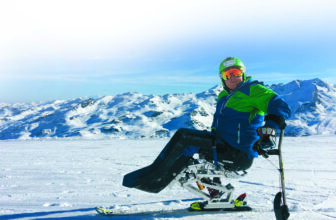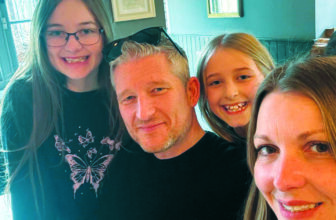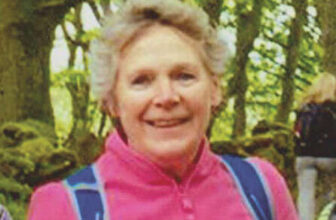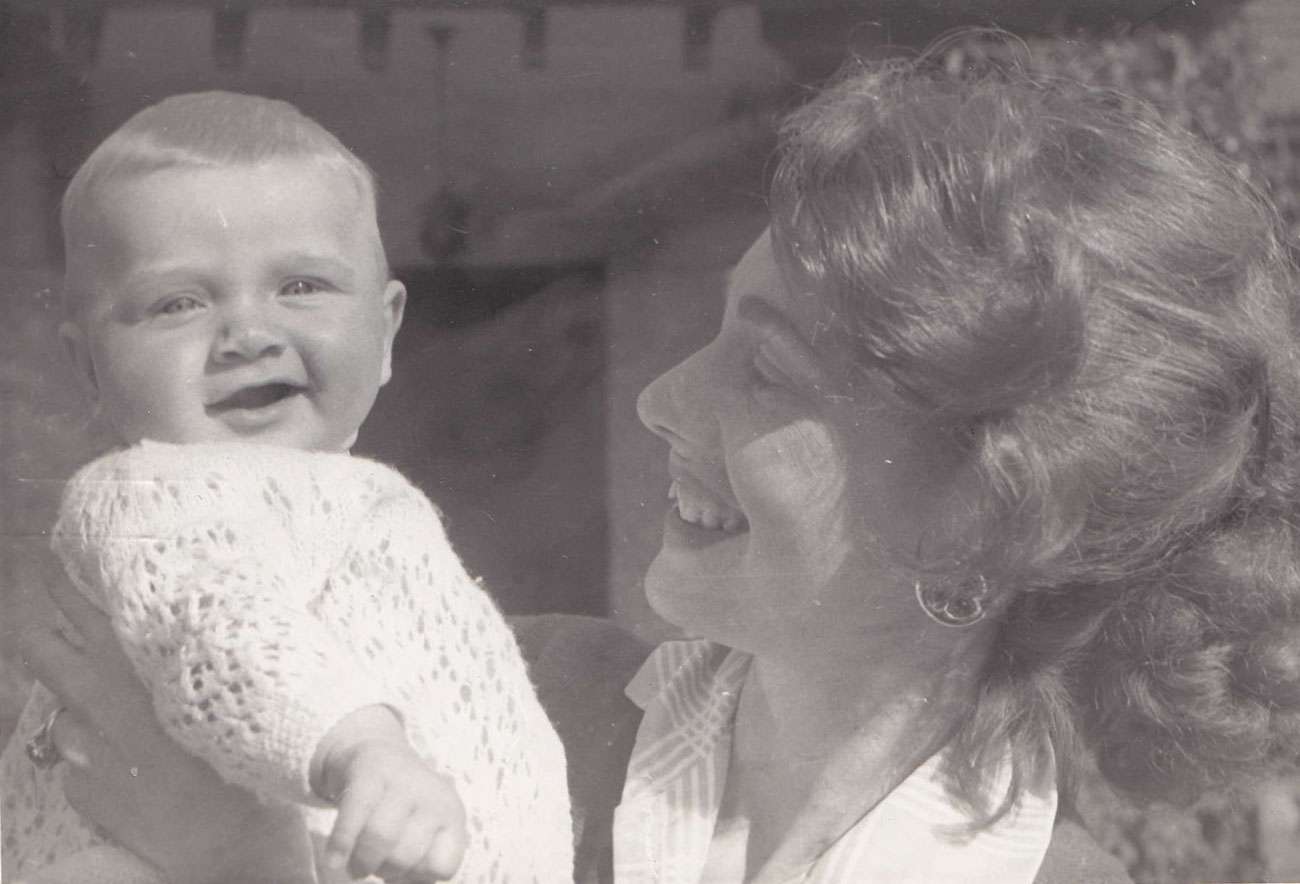
Happy days with my Mum. I still have the piece of jewellery I gave her as a present when I was older
I was born in 1960 in Chelsea, London and moved to Virginia Water in 1961 with my parents and brother, who was 4 years older than me.
The move was inspired by mine and my brother obsession with nature and my father’s desire to raise the family outside of London. My dad was in the pub one day when someone said ‘Oh there’s someone down the road that’s selling their little bungalow with half an acre of garden’. And that was it – we moved! I can remember my dad picked up my mum from Egham station and drove as fast as he could to the house, to make it seem as though the distance between being in the town and out of town was shorter! It seemed to work because they agreed to buy the house.
We were quite an artistic family. My Mum was a fashion designer, having studied fashion design and illustration.
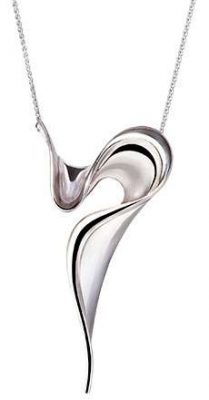
Silver Ebb’n Flow neacklace
When children came along, she branched into Ladybird books. In fact, she drew all the illustrations in those old stories, as well as various commissions for people.
My dad was a set designer in the film industry. He worked at Shepperton Studios which was fairly close to Virginia Water, so he was able to travel to work very easily. However he worked on a self-employed basis and when the film industry started to struggle, he found himself in need of more regular work in order to support his growing family.
It was at this time that he joined PSC, a concrete firm, selling sand to the Arabs. My dad always had a certain charm about him and could be very persuasive, so he didn’t have to do much to hit his targets over the 20 years he was there. He later made a good friend called Terry Richmond, who asked him to come and work for him in the oil industry.

Me in my pram
My dad was in the SAS in the war and had worked out in the Middle East for a while so he knew the Arabs and the culture well. They would set up exhibitions to sell their products and he would design all the exhibition stands as well as selling from them.
As soon as my brother and I could hold a pencil in our hands we would be drawing and could always be kept quiet with a couple of crayons. When I was in primary school at Thorpe, a little village school, I excelled in art and knew even at that early stage that it was the way to go. It wasn’t a chore to me. I was very influenced by my brother’s love of nature and we used to draw a lot of birds.
I then attended Charter School in Sunningdale from 11 to 16 years old, where I was top of my class in Art. My teacher Mr Fry was great, but when he retired, the next teacher had us studying progressive art, which didn’t really suit me. He was into surrealism and off the wall stuff, so sadly I lost interest for a little while.
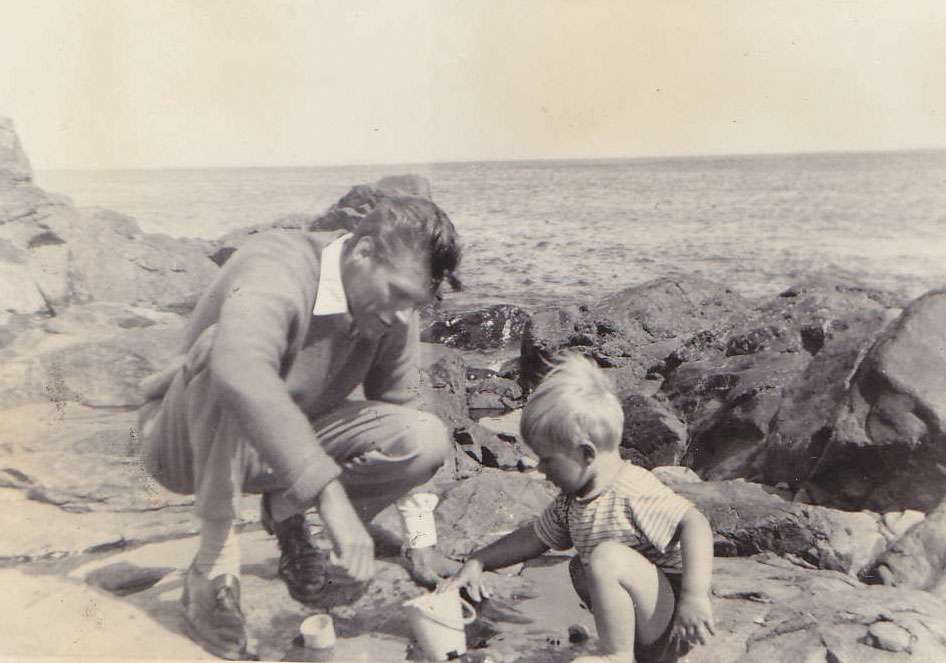
Me and my Dad at the beach
While I was in my fourth year at Charters, I made a friend who introduced me to photography. I loved photography and was surprised by how scientific it was. I was fascinated by the fact that you could compose a picture and alter the final effects with different lighting techniques and thought it was great to photograph things you were really interested in. His parents had a place down in Cornwall and I used to spend almost all my summer holidays there. We had such good fun with photography and art. We would even draw up pretend invoices to each other and charge silly amounts of money for our work!
After I finished school, I didn’t really know what I wanted to do. I had taken GCSE’s and CSE’s exams because I was sort of borderline at the time, but I didn’t really apply myself in my studies if I wasn’t interested and so I left school with pretty average exam results.
I then went to Windsor College, where I met a fabulous guy called Mike Roles who taught photography and we just had such a ball. I found my photography degree easy because it really interested me. While I was there, my dad said ‘You really ought to go into the film industry, I think you’d like it because of your interests.’

My Mum and Dad at the park
At the end of my photography course I saw an advert in the paper in the film industry at British Aerospace. I went for an interview which went well but unfortunately there was a younger apprentice who’d come straight from school and knew all about film. However, it turned out they were so impressed with me that about a month later I got a call from them saying, ‘Look we’ve got another position, not an apprenticeship, you will be a junior photographer’. Of course, I was delighted.
Fortunately, they agreed that I could work for them part-time while I finished my course and once I had my degree, I had a full-time job ready and waiting. We filmed airplanes at the old British Aerospace site at Brooklands, which to be completely honest, I found pretty boring. The crew there were great though. We were working in the ‘Bouncing Bombs’ (Barnes Wallace’s) office. The film archive was downstairs, with the original photographs of the bouncing bombs.
We had the whole team there; sound crew, editing and so on. We quite enjoyed the elitism of it, truth be told. Other factories had things like weather machines for example, that could alter the weather for testing aircraft wings. We were often asked to go out and film at places for research. Sometimes they’d even make snow for us and we’d have snowball fights in the summer. It was great fun and we played just as hard as we worked in those days.

The original piece of jewellery that caught my eye in Scotland and changed my life and career
I found my forte in doing the titles at the beginning and end of films. In those days you had to electro set them all precisely, starting from the middle and working outwards. I fortunately never made a spelling error which is probably why they had me do it! I moved up from there to filming the aircrafts, but I still felt a sinking feeling deep in my heart that I wasn’t achieving what I wanted. It was an empty hole that I couldn’t fill.
‘Still’ photography was never an individual’s work, so when taking a shot, apart from cropping it, the films went on to editors and sound people and by the time they were completed it wasn’t your shot anymore. It belonged to a whole group of people and I found that dissatisfactory. So I started to look around for an alternative job, but couldn’t find one.
It was around this time that I met my future wife. I was in a pub relaxing with friends following our Amateur Dramatics meet up, when we were joined by a group of girls that some of the lads knew. Alix was one of the girls and we started chatting that evening and then started dating. She was studying Microbiology at Ashford hospital at the time, where they often held fancy dress parties. We would go along to the parties with our group of friends and of course we had the whole wardrobe of the Amateur Dramatics group to choose from. We would dress up in the most ridiculous outfits and go to these doctors and nurses’ parties. Even there my artistic side showed itself. I recall a Halloween party at the hospital when together with our group of friends we went as a dragon in true Chinese style. Hidden beneath the dragon costume we arrived at the party in a great long line and then took the dragon costume off to reveal our Halloween regalia underneath!
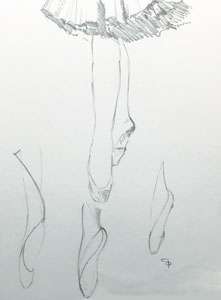
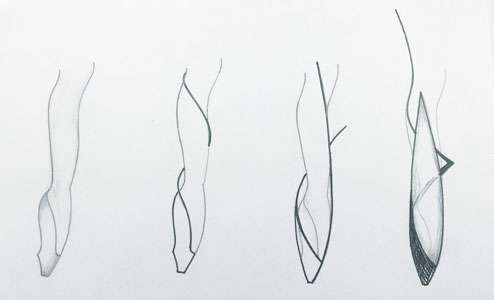
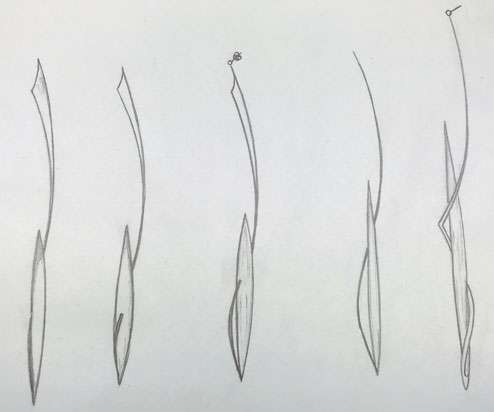
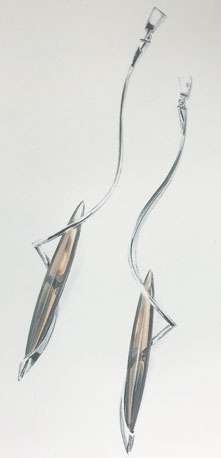
Sketches showing an original idea for piece of jewellery based on a ballet shoe and dance movement, then the final design
Subsequently about 1980 when I was 20, Alix and I decided to go on holiday together though we couldn’t afford much in those days. We drove up to Scotland in an old banger and toured around and it was just lovely. The scenery took me back to the ways of the country and reminded me of when I was really young. I engaged with the Scottish people, but what I really loved was discovering the little craft sites which completely caught my imagination. I was amazed that these folk would literally come out of College and set up their own studio, in the middle of nowhere and make a living out of it.
As we toured around, we found craft studios dotted around all over the place, in various little villages. There would be a group of them – one would do glassblowing, another jewellery and another one would be doing leatherwork. They seemed like fantastic communities to be involved with and everyone was individual and had their own ideas. Of course, they had to be commercial in a certain respect but it wasn’t like down South where everyone had the pressure to be in a job that earned money.
I looked around the various studios and one really caught my imagination where they were melting gold from a solid to a liquid and forming it back into a different solid shape. That fascinated me with all the related technical skills; hammering and raising a piece of silver and moulding it into a shape. One piece of jewellery that caught my eye, which I bought for my mother, was a piece of silver in the shape of a tree, with a piece of oak in the centre.

Lilly silver torque necklace
Combining the two materials was really lovely. It inspired me how it created something so special and individual that would never be found in a high street shop. So when I returned home something just clicked inside, jewellery making just seemed the right thing to do and everything fell into place after that holiday. I was with the person I ended up marrying and I’d discovered a career I really wanted to pursue. I knew it was something that would fulfil me constantly because of the individual design each day. For me the film industry work represented the same chores all the time. The jewellery designing would combine my love for nature and my artistic inclination.
Once I’d reached the decision I basically came home and announced it to my parents. My mum was fantastic. She’d always been right behind me and it was her who got me into the photography course in Windsor College initially. When I came back and spoke to her she said, “Well College is the way to go, you need proper training for this.” My parents always believed if you want to do something you’ve got to do it properly and I’ve taken that on too.
I had an interview at Epsom School of Art and Design, after my mum had found out all about it. I’d missed the September start date at that point but went and had a look around. I liked what I saw and they liked me. Aged 21 by then I was a mature student and my contemporaries there were 17-18. The enthusiasm I showed seemed to convince them and I was offered a place to get an independent degree. I was awarded a student’s grant which was fantastic. It was a 3-year course – a proper degree. Working jewellers would come in and teach us, so it wasn’t just our regular lecturer. We had various people come in from the industry adding interest, and it brought that side of things into our learning which was vital.
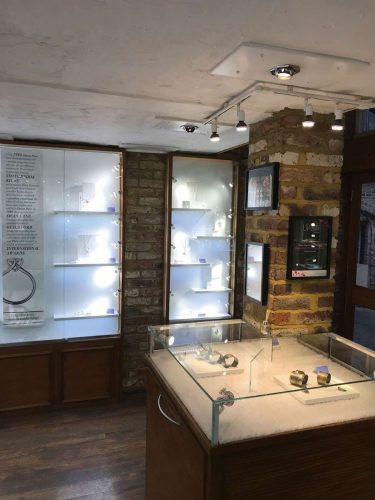
Smithbrook Kilns shop
With a college course it gives you the summer holidays free. During that time I began looking for a job at the unemployment centre, when I saw this little card which said ‘Jeweller required’. I couldn’t believe my luck, an actual jeweller’s job in the unemployment centre! I went for an interview with this young lad, who was younger than me. He absolutely loved jewellery and his parents had set him up in business. I got the job and although the work was to a higher level than I was used to at college, he stuck with me.
We got along very well that summer and with his guidance I became proficient at fairly intricate jewellery work but when the summer break ended, I had to return to college. We kept in touch and at the weekends and in subsequent college holidays I would join his team. So when I finished my degree I had a job to step into. He paid me 80p an hour as a student but increased it to a pound once I was qualified!
There are many facets to jewellery; such as being a setter, a diamond mounter or an engraver. There’s so much to choose from and normally you develop in one area and not another. I established myself there working for 2 and a half years. Then I met Kevin Rogers, who’d done the opposite of me. He left school and went straight into a 5 year apprenticeship up in Bond Street, London. The London Jewellers would come down to schools out of the city and look for talent. His school said he was brilliant at metalwork and they offered him a trial in London leading onto the apprenticeship. Eventually he got tired of commuting to London and set up in business in Woking which is where we met. We were a good blend – Kevin had the skills on the practical side and I had the artistic skills.
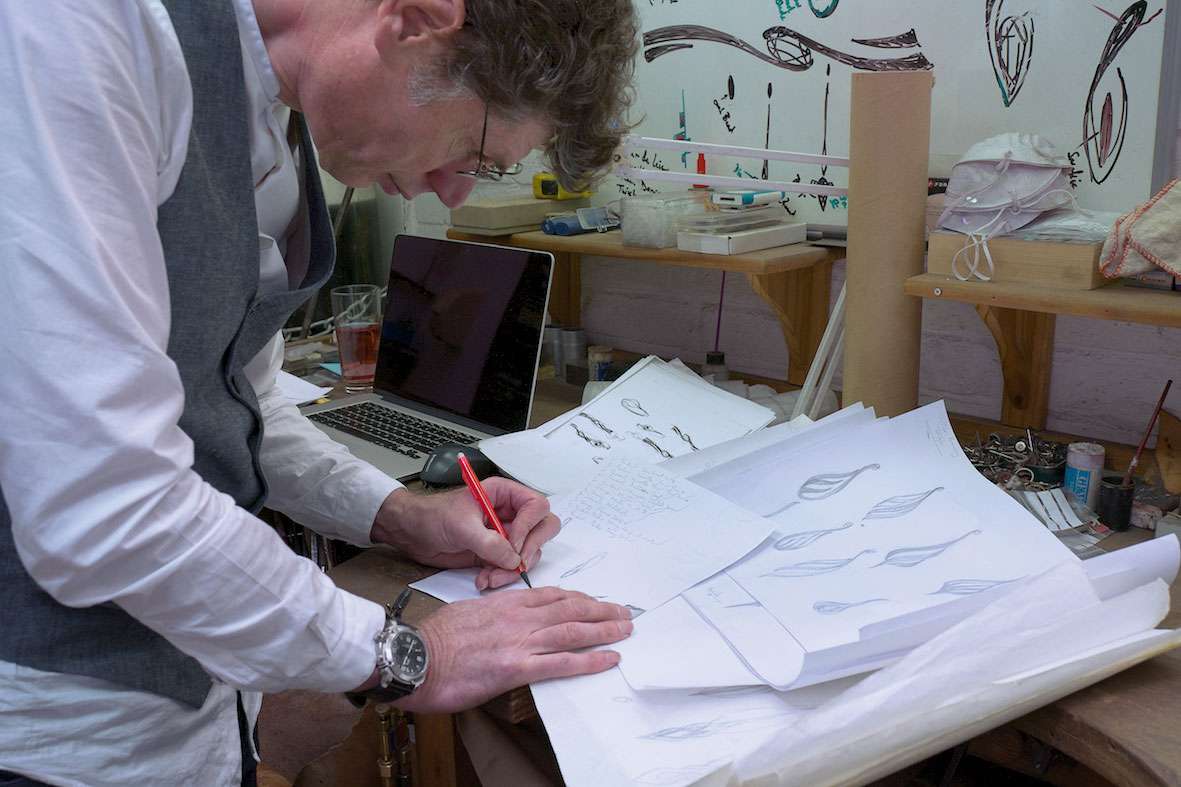
Checking the drawing designs
We agreed we didn’t want to set up in a traditional jewellery business, we wanted to do something contemporary. I was living in Shalford at the time and he was living towards Mayford. As we looked around the area Kevin found Smithbrook Kilns. We chose the unit we thought was best, bought all the tooling required and set up. We have never looked back since.
On reflection we were a bit rash to give up on our previous jobs and step into something so new. Even though we were all set up and ready to go, people didn’t just come through the door. We each knew certain other jewellers who we did work for, that was our base money. This gave us time to build up a collection to put in the unit window. We built a shelf and put a basket on it, no bigger than 2ft by 1ft. We added felt to line it and displayed our jewellery there. It was our sole collection, about 6 to 7 pieces, but they sold and business started to build up, slowly expanding to give us a steady income. On the back of this we were able to drop the trade work as we had enough customers. As business improved, we opened the unit next door to us, giving us a workshop in the shop. Subsequently we moved to another unit, purpose-built for us providing skylights for natural light to work with and a spacious showroom.
In 2000 we opened up a shop in Guildford and that location brought in more work. We had a nucleus of loyal customers, collecting our pieces, liking our work and wanting regular different designs. We established a pattern of holding a sort of ‘fashion show’ of pieces throughout the year. For example, we would create a collection for the following year, show that first in the summer, and continue with more shows as we moved towards Christmas because that was our peak selling time. We’d invite our customers to enjoy some champagne and nibbles, clear the whole shop and put all the new pieces on display, about 20 to 30 in all. It took a whole year to design and makeup with Kevin’s help. Our guests would see the new pieces and we’d assess their response to establish which pieces were popular. People would gravitate to the design they liked, possibly even one or two. Those designs we would keep and expand. When the private views were happening if a collection didn’t have a bangle for example, we would make one and some stud earrings and build on those collections every year. We would knock out the ones that didn’t work, so the designs grew stronger all the time. There are designs in our collection today which I designed when I was at college and are still going.
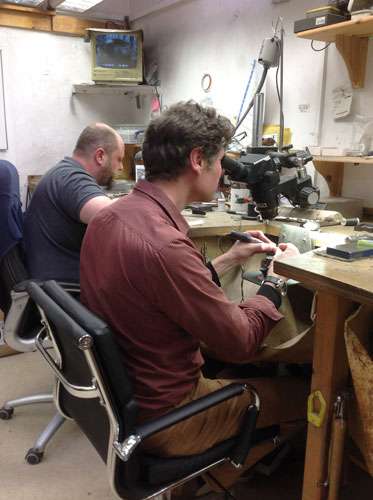
Steve in the workshop
When I started to design jewellery pieces, I would combine what I knew and loved from the countryside. As I said I was always into nature and leaves and drew designs from that. I knew about nature so I tried to develop simplistic designs, straight lines, curvatures found in nature. I expanded it from there. At that time fashions were different so over time I’ve had to convert or adapt them to see them through the trends. We’ve been through three or four downturns in the economy over the years and the jewellery market is always one of the first to be affected because basically it’s isn’t a necessity, you can’t eat your necklace!
So we had to adapt and change in that respect but always kept the essence of our designs. We got other jewellers in and promoted British designers during difficult times over the years. My designs were 50% what we do, now they are 90%. We tended to find that we were selling our own stuff more than others. Theirs would be in fashion for a period and then go out of fashion. With our designs they have never really been ‘in’ nor been ‘out’ of fashion. People continue to wear designs they bought when we first started, because it’s still wearable.
We’ve kept continuity in our showrooms. We don’t sell things like watches which would have brands spoiling the look inside. Our showrooms are consistent throughout. There isn’t one ‘looker’ in one corner and another in the opposite corner. That is really important to us. We wanted to maintain an artistic side to the design of the shelves to show the pieces off to their main advantage. If you’ve designed contemporary jewellery you don’t want the standard felt to display it on. That’s also where my photography came in useful in the early days. I would photograph our pieces. It was a complete journey. It’s amazing how the jewellery combined everything I was good at. I could take a really cracking shot and it would sell, rather than an average shot.
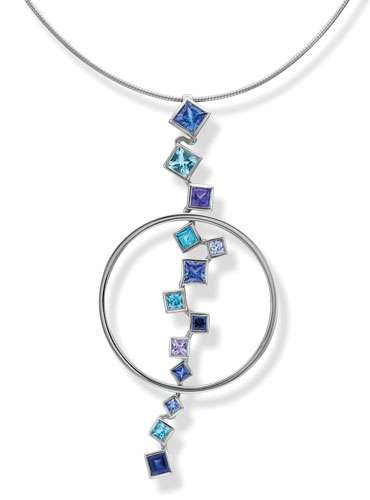
Award Winning Waterfall pendant
Coming into the workshop is not like a job to me at all, it never has been. It’s one of the reasons why we chose Smithbrook Kilns. The setting is close to nature here, a nice working environment, peaceful, away from the chaos. Just travel into Guildford and there’s constant people and noise and I’m not comfortable in that environment.
I look at the world from the eyes of a Jeweller. I will see shapes that would make a nice pair of earrings, or a broach. A bird flight might be a woodpecker going up and down in its flight pattern, which will inspire a shape to go into a chain, with its continuous line. There’s lots of inspiration all around and of course it can be expanded and developed constantly.
Finding a name for the business was an interesting journey. Initially we were a ‘Jewellery Studio’. In those early days, the term ‘studio’ wasn’t used in many places. It was a working environment where people could come and see actual pieces being created. By the time we moved to Guildford, the term ‘studio’ was being used everywhere and jewellery was tagged onto everything and it had become a bit of a ‘cottage craft’.
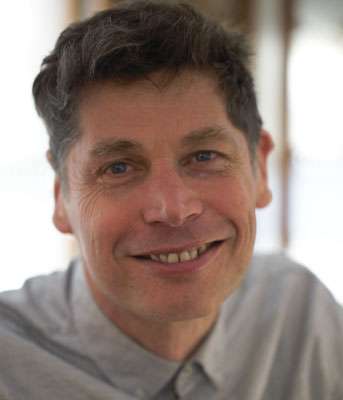
Steve Parsons – Jewellery Designer
We decided we needed a catchier name. Because it was just the two of us, we didn’t want to go under each other’s names. That wouldn’t be beneficial, it could cause conflict, so we came up with ‘pure’ to reflect the pure metals we used. We were working with silver, gold and platinum, all pure metals. I looked up ‘pure’ in a thesaurus for inspiration. It had ‘Simon Pure’ in there which apparently means ‘The Real McCoy’, ‘What you see is what it is’, ‘Genuine Born’. I thought that was perfect. I imagined that if a professor came along, he would see the sign ‘Simon Pure’ and understand the full meaning of the name straightaway. It’s also appealing as a name too which helps. The only problem is I’m now known as Simon Pure so I see it as my stage name alongside my real name.
If I had any tips for jewellery artists I think research is key. Don’t just jump into things. Ask lots of questions, don’t be shy. We take part in shows like the Islington Design show and there are a lot of students who come along and they back off when approached. It’s a big shame because Designers wouldn’t bite their heads off, they most generally want to inspire, give feedback and help because they were once in the same position. At the end of the day it’s not what you know but who you know.
Looking back on my life, having artistic parents helped me to view the world differently and my trip to Scotland was most significant, a real turning point, I didn’t even know about jewellery until then. Subconsciously I was always heading in an artistic direction but those early days and inspirational moments, ‘diamond days’, have fashioned me into the person that I am today. ![]()
To contact Steve Parsons at Simon Pure:
Tel: 01483 273111 / 01483 506111
or Email: info@simonpure.co.uk
www.simonpure.co.uk



